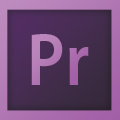
Adobe Premiere courses
- Premiere Beginner Course
- Premiere Advanced Course
| Course Date | City | Course Times | Cost | |
| December | ||||
| 09 Dec - 10 Dec | Live Online | 0900 - 1600 | R9000 | Book |
| Course Date | City | Course Times | Cost | |
| 09 Dec - 10 Dec | Live Online | 0900 - 1600 | R9000 | Book |
Premiere CS5, CS6, CC beginner course
Course Description:
This 2-day course covers the basics of learning Adobe Premiere, and countless tips and techniques to help you become more productive with its new features, including new multicam editing tools, auto-creation of menu-based DVDs from the timeline, and Native HD, SD and HDV support, and more.
Learning Objectives:
In this course, you will learn how to:
- Work with audio
- Create transitions and titles
- Manipulate subclips and virtual clips
- ... and more.
Target Audience:
Students who need to know the basics of Adobe Premiere, and countless tips and techniques to help them become more productive with new features.
Premiere beginner course
Course Outline:
1. Getting Started with Adobe Premiere
- Topic A: Explore the Premiere Pro Interface
- Topic B: Customize the Workspace
- Topic C: Create a Project
2. Assembling a Project
- Topic A: Import Assets
- Topic B: Organize Media Files
- TopicC: Add Clips to a Sequence
3. Editing a Sequence
- Topic A: Edit Footage
- Topic B: Edit Clips
4. Enhancing a Sequence
- Topic A: Apply Effects
- Topic B: Add Transitions
- Topic C: Add Text
- Topic D: Create a Composite
5. Working with Audio
- Topic A: Adjust Audio
- Topic B: Apply Audio Effects
- Topic C: Work with Merged Clips
6. Exporting Videos
- Topic A: Export a Movie File
- Topic B: Review a Movie File
7. Working with Adobe Encore
- Topic A: Import Assets to Adobe Encore
- Topic B: Add Chapters and Subtitles
- Topic C: Create a Menu
- Topic D: Create a Slide Show
- Topic E: Add Navigation to a Menu
- Topic F: Export a Project
Our outlines are a guide to the content covered on a typical course. We may change or alter the course topics to meet the objectives of a particular course.
Sorry, we currently do not have any public courses scheduled for the Premiere level 2 course. Please contact us to see if we can put one on the schedule for you
Sorry, we currently do not have any public courses scheduled for the Premiere level 2 course. Please contact us to see if we can put one on the schedule for you
Premiere CS5, CS6, CC advanced course
Course Description:
This 2-day intermediate course covers additional techniques in Adobe Premiere.
Learning Objectives:
In this course, you will learn how to:
- Work with Adobe Media Encoder
- Perform time remapping
- Mix audio
- Explore composting techniques and keying
- Use nested sequences
- ... and more.
Target Audience:
Premiere users who are familiar with the basics and want advanced their skill level.
Premiere advanced course
Course Outline:
Lesson 1: Changing time
- Getting Started
- Using slow-motion and reverse-motion techniques
- Enabling variable time changes with time remapping
- Applying time remapping with speed transitions
- Using time remapping with reverse motion
- Recognizing the downstream effects of changing time
- Changing the speed of multiple clips simultaneously
- Changing the length of multiple stills simultaneously
- Review questions
- Review answers
Lesson 2: Acquiring and editing audio
- Getting Started
- Setting up a basic voice-recording area
- Voicing professional narrations
- Creating a high-quality aural experience
- Examining audio characteristics
- Adjusting audio volume
- Adjusting audio gain
- Adding J-cuts and L-cuts
- Review questions
- Review answers
Lesson 3: Sweetening your sound and mixing audio
- Getting Started
- Sweetening sound with audio effects
- Trying stereo and 5.1 surround sound effects
- Working with the Audio Mixer
- Outputting tracks to submixes
- Recording voice-overs
- Creating a 5.1 surround sound mix
- Fixing, sweetening, and creating soundtracks in Adobe Soundbooth
- Review questions
- Review answers
Lesson 4: Analyzing content
- Getting Started
- Transcribing speech to text
- Enhancing the accuracy of speech analysis
- Searching transcription for keywords
- Setting In and Out points using speech analysis text
- Modifying the metadata
- Detecting faces in a sequence
- Review questions
- Review answers
Lesson 5. Exploring Compositing Techniques
- Making compositing part of your projects
- Working with the Opacity effect
- Combine layers based on a blend mode
- Working with alpha-channel transparencies
- Color keying a green-screen shot with Ultra Key
- Using matte keys
Lesson 6. Working with Color, Nested Sequences, and Shortcuts
- An overview of color-oriented effects
- Adjusting and enhancing color
- Using nested sequences
- Nesting clips
- Getting to know the recommended keyboard shortcuts
Lesson 7. Managing Your Projects
- Project menu overview
- Using the Project Manager
- Importing projects or sequences
Lesson 8. Exploring Adobe Onlocation
- Setting up Adobe OnLocation
- Calibrating your camera with Camera Setup Assistant
- Recording live video
- Recording video to a shot list
- Analyzing video with Adobe OnLocation
- Importing clips not captured with Adobe OnLocation
- Importing OnLocation clips with the Adobe Premiere Pro Media Browser
Lesson 9. Using Photoshop and After Effects to Enhance Your Video Projects
- Exploring Adobe Creative Suite 5 Production Premium
- Importing Adobe Photoshop files as sequences
- Using Dynamic Link with After Effects
- Replacing a clip with an After Effects composition
Lesson 10. Exporting Frames, Clips, and Sequences
- Overview of export options
- Recording to tape
- Exporting single frames
- Using the Export Settings dialog
- Working with Adobe Media Encoder
- Format overview
- Using the formats
- Exporting to mobile devices
- Exporting to Final Cut Pro
- Working with edit decision lists
Lesson 11. Authoring DVDs with Adobe Encore
- Overview of DVD authoring in Adobe Premiere Pro
- Adding Adobe Encore chapter markers to the Timeline
- Creating an autoplay DVD
- Creating a menu DVD
- Creating a Blu-ray Disc
- Exporting DVD projects to Flash
Our outlines are a guide to the content covered on a typical course. We may change or alter the course topics to meet the objectives of a particular course.


